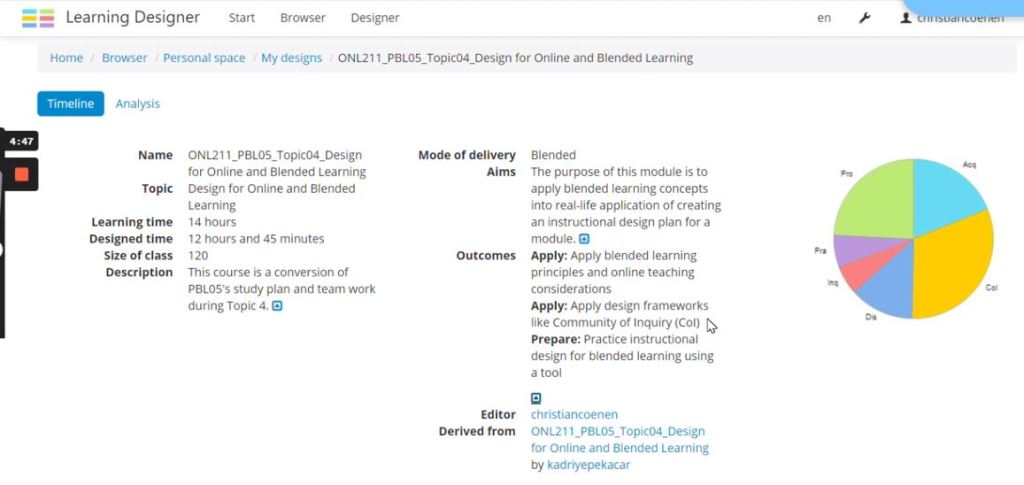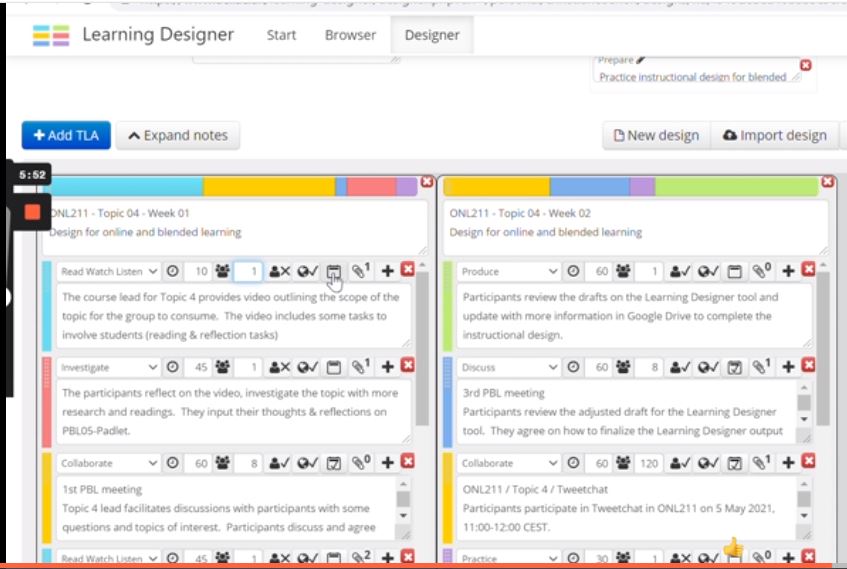Blended Learning is a topic close to my heart because I am currently leading an internal task force to propel ourselves quickly into this area. The learnings from ONL211 give me some ideas and insights into this space, although there are a lot more to explore when it comes to implementation.
The tweet chat session started with the first good question on ‘what will the learners actually be doing’ when it comes to designing for blended learning. This flips the instructional design perspective to first consider the learner and not just the teaching from the lecturer’s perspective.
As part of our PBL05 group FISH presentation, we decide to use the Learning Designer tool to design the blended learning experience of ONL211 Topic 4, but with the perspective of the learner and what they will be doing. We have also documented the entire process via Loom video.
This free Learning Designer tool is useful to help instructional designers visualise the types of learning activities that are planned for the learners. The key is to have a balance of different types of activities to engage and motivate the learners. As you can see from the pie chart, we have designed a balance of 6 learning activities across the blended program.
 Sample of Blended Learning Program using Learning Designer
Sample of Blended Learning Program using Learning Designer
The tool uses 6 learning activity types proposed by Laurillard (2012), which includes learning through Acquisition, Inquiry/Investigation, Discussion, Collaboration, Production and Practice. Each of these activities focus on different aspects of learning. Learning through Acquisition involves knowledge accumulation while learning through inquiry and investigation requires exploration, analysis, comparison and critique. Learning through discussion and collaboration involves social participation, sharing and negotiation in the process of building knowledge. Lastly, learning through practice and production enables the learner to apply the knowledge and consolidate their thinking.
 Six Types of Learning Activities (Laurillard, 2012)
Six Types of Learning Activities (Laurillard, 2012)
We have used these learning examples in our PBL05 Learning Designer – including Read/Watch/Listening to webinars, Investigate using the FISH model, Collaborate in PLB meetings, Discuss and review our approach to present the findings, Practice in using the Learning Design tool and lastly to produce the loom video as an output for topic 4. See example below.
 Sample of Blended Learning Course using Learning Designer
Sample of Blended Learning Course using Learning Designer
Loom Video for PBL05 Group – Designing a sample Course for Blended Learning
I find this way of organising the learner experience useful and it also serves as a reminder that blended learning is not just viewing of videos online. There are multiple types of learning activities that we can use to engage and motivate the learners as well. In fact, I have shared these 6 learning activity types with my own organisation as part of the guidance in instructional design, so that our lecturers will incorporate a wealth of these activities in their blended learning design.
Another question asked in the Tweet Chat is about ‘what should a teacher do in order to engage students online’. This is a rather difficult question to answer. Due to the difference in space, time and context when students learn in the digital space, teachers are unable to read the signals of engagement directly. As such, indirect methods such as consciously designing in opportunities for discussion, collaboration, practice and production of some output would become essential to indicate engagement and learning. Nevertheless, looking at the multiple LMS (Learning Management Systems) in the market, most are still focusing on the ‘teaching’ aspects rather than ‘learning through collaboration’ or social learning aspects. As such, we will need to consciously add these elements through alternative online tools.
Using the Community of Inquiry Framework (Garrison et. al., 1999) as a reference, the entire educational experience for the learners depends on three areas of presence, cognitive, social and teaching. Not only does the lecturer need to provide the right content to drive engagement, they also need to support regulated learning through direction, goals, motivation or nudging. The social aspects of learning and engagement with other participants also need to be incorporated in instructional design to provide a constant source of support and spirit of community and belonging. I find this classic framework a good reminder of what we need to consider when we design for blended learning. Our lecturers are subject matter experts and tend to gravitate more towards the content delivery (cognitive presence), leaving the other two aspects to chance. By using this framework, I would influence our lecturers to also consciously design the necessary conditions for learning.
One interesting approach proposed by Salmon and Wright (2014), is the use of the method ‘Carpe Diem’ learning, to co-create instructional design through an interactive workshop. This looks very similar to the design thinking workshops that I conduct, where the power of the group is being harnessed for focused ideation and co-creation. This is an area which I am keen to explore when we work on our blended learning curriculum design. By focusing on the learners, their activities and experience throughout the flow of the learning journey, and by including alternative perspectives from other lecturers, we may be able to produce a prototype quickly and iterate it along the way.
Another interesting 2×2 framework proposed by Salmon (2014, 2016) on innovation in learning design, is to examine the current strengths, capabilities and technologies of the universities and consider which quadrant of innovation the organisation would like to pursue. According to Salmon (2014, 2016), Quadrant 1 and 2 relate to incremental innovation. In quadrant 1, understanding current organisational capabilities and technologies help to fine-tune and improve learning experiences, where in quadrant 2, there is a stretch to explore new markets, new type learners and new missions. In Quadrant 3, the focus in on offering new technologies, new prototypes and experiments of learning experiences driven by technologies. In Quadrant 4, learning takes a radical innovation approach, entailing going to a space ‘untraveled’ exploring and navigating a new dimension and creating a new experience and product for a new audience. This is another useful framework for considering our strategy for blended learning, and I would explore this further within the team.
Finally, Salmon (2019) speaks about Industry 4.0 and subsequently the need to spearhead our thinking for Education 4.0 for a new generation of learners. Indeed, the education space is ripe for disruption and this will be a new and exciting space to play in and to explore in the near future.
REFERENCES
Garrison, D. R., Anderson, T., & Archer, W. (1999). Critical inquiry in a text-based environment: Computer conferencing in higher education. The Internet and Higher Education, 2(2), 87-105. https://doi.org/10.1016/S1096-7516(00)00016-6
Laurillard, D. (2012). Teaching as a design science: Building pedagogical patterns for learning and technology. New York, N.Y: Routledge.
Salmon, G. (2014). Learning innovation: A framework for transformation. European Journal of Open, Distance and E-learning, 17(2), 220-236.
https://www.gillysalmon.com/uploads/5/0/1/3/50133443/learninginnovation_salmon_2014_oa.pdf
http://www.eurodl.org/?p=current&article=665
Salmon, G. and Wright, P. (2014) Transforming future teaching through ‘Carpe Diem’ learning design. Education Sciences, 4(1), 52-63. https://res.mdpi.com/education/education-04-00052/article_deploy/education-04-00052.pdf
Salmon, G. (2016). Keynote Speech at the ETinEd Conference, UCT, 2015: for BJET Special Issue 47(5), 2016.
https://www.gillysalmon.com/uploads/5/0/1/3/50133443/realmoflearninginnovation_salmon_2016_preprint.pdf
Salmon, G. (2019). May the Fourth Be with You: Creating Education 4.0, Journal of Learning for Development, v6 n2 p95-115 2019. https://eric.ed.gov/?id=EJ1222907